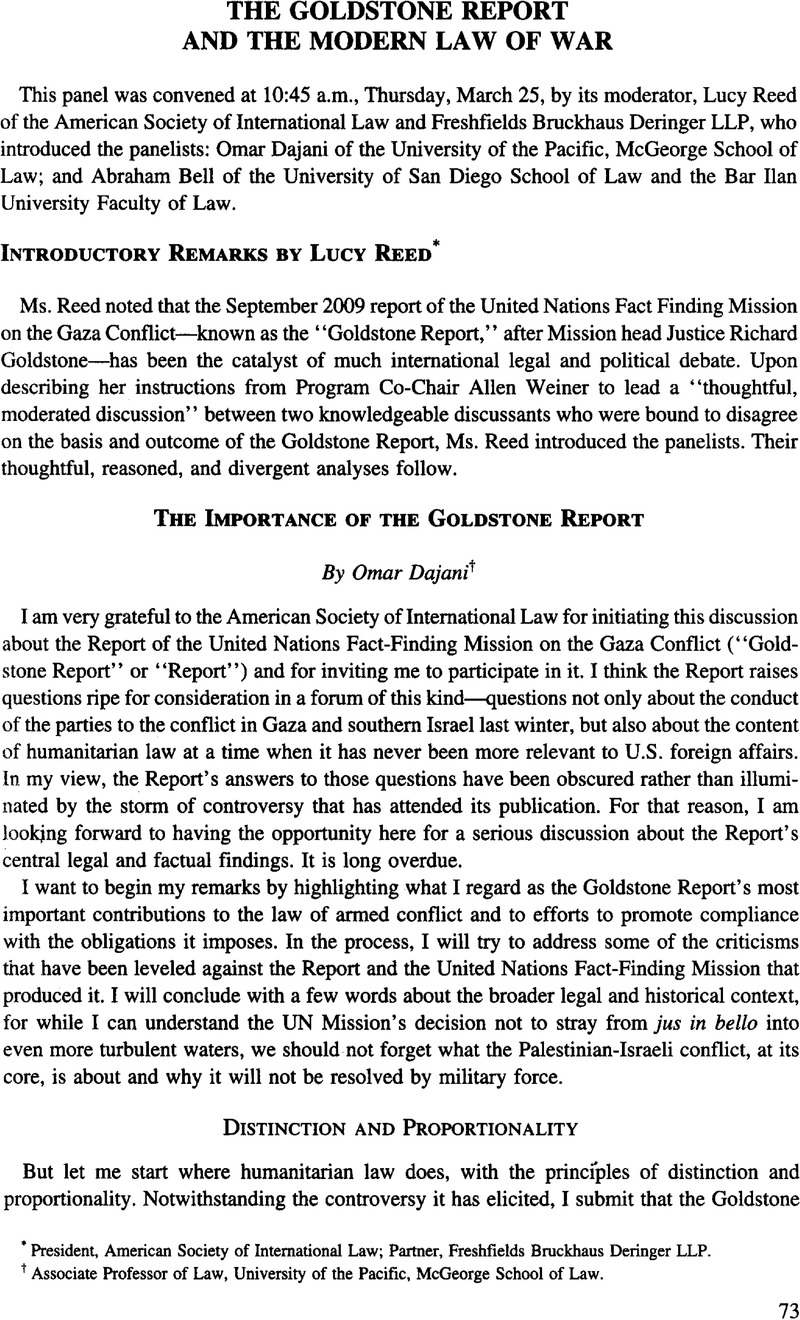No CrossRef data available.
Published online by Cambridge University Press: 28 February 2017

1 UN Human Rights Council, Report of the United Nations Fact-Finding Mission on the Gaza Conflict, paras. 365-92, UN Doc. A/HRC/12/48 (Sept. 25, 2009), available at http://www.un.org/Docs/journal/asp/ws.asp?m=A/Hrc/12/48 [hereinafter Goldstone Report].
2 Id. at paras. 372-73.
3 Gaza Airport Runway Ripped Up by Israel, Guardian (Jan. 11, 2002), available at http://www.guardian.co.uk/world/2002/jan/11/israel2.
4 Protocol Additional to the Geneva Conventions of 12 August 1949, and Relating to the Protection of Victims of International Armed Conflicts, Art. 52(2), June 8, 1977, 1125 U.N.T.S. 3 (entered into force Dec. 7, 1978) [hereinafter Additional Protocol I].
5 Goldstone Report, supra note 1, at paras. 384-87.
6 Id. at para. 388.
7 Id. at para. 419.
8 Id. at para. 435. of course, the Report’s recognition that some of the members of Gaza’s police force may have continued to be involved with armed groups like the al Qassam Brigades bears a striking contrast to the government of Israel’s conflation of membership in Hamas with involvement in the Qassam Brigades, both of which it considered grounds for combatant status. See Israel Ministry of Foreign Affairs, the Operation in Gaza: Factual and Legal Aspects, para. 247 (July 2009), available at http://www.mfa.gov.il/MFA/Terrorism-+Obstacle+to+Peace/Terrorism+and+Islamic +Fundamentalism-/Operation_in_Gaza-Factual_and_Legal_Aspects.htm. As the UN Mission concluded, the police officers’ political affiliation with Hamas was not, alone, a valid basis for establishing combatant status. Goldstone Report, supra note 1, at para. 428. Past involvement was similarly inconclusive. Id. at 418. Indeed, the fact that some members of the police force had been members of armed groups years earlier is no more illuminating, with respect to establishing combatant status, than the fact that most (if not all) of the members of Israel’s civilian police previously served in the Israel Defense Forces. And while some Palestinian armed groups appear not to have abided by their obligation to wear uniforms distinguishing them from the civilian population, it is difficult to see how this failure could justify air strikes against the uniformed civilian police during the first minutes of Operation Cast Lead. In view of the serious doubts regarding how many of the hundreds of policemen killed were or had ever been combatants, it is unsurprising that the UN Mission concluded that Israel’s attacks on civilian police facilities in Gaza were disproportionate.
9 Goldstone Report, supra note 1, at para. 926 (quoting Additional Protocol I, Art. 52(3).
10 Id. at para. 803 (quoting Breaking the Silence, Soldiers’ Testimonies From Operation Cast Lead, Gaza 2009 (2009), available at http://www.shovrimshtika.0rg/UserFiles/File//ENGLISH_oferet.pdf).
11 Id. at para. 804.
12 Id. at paras. 704-885.
13 See Bill Moyers Journal: Interview with Richard Goldstone (PBS television broadcast Oct. 23, 2009), transcript available at http.//www.pbs.org/moyers/jounial/10232009/transcript1.html.
14 Goldstone Report, supra note 1, at para. 587 (quoting Final Report to the Prosecutor by the Committee Established to Review the Nato Bombing Campaign against the Federal Republic of Yugoslavia, para. 28(c), 39 ILM 1257 (2000)).
15 Id. at paras. 543-95.
16 Id. at paras. 593-95.
17 See, e.g., id. at paras. 623 (unprovoked attack on Ai Quds Hospital), 742 (unprovoked attack on civilian), 769 (same), 786 (same), 837 (unprovoked attack on mosque), 878 (unprovoked attack on condolence tents), 929-30 (unprovoked attack on flour mill), 974 (unprovoked attack on wastewater treatment plant).
18 See id. at paras. 437-38, 810.
19 Israel Warns Hezbollah War Would Invite Destruction, Reuters (Oct. 3, 2008), at http://www.reuters.com/article/idUKTRE4923I020081003.
20 Id.
21 Siboni, Gabriel, Disproportionate Force: Israel’s Concept of Response in Light of the Second Lebanon War, INSS Insight 74 (Oct. 2, 2008)Google Scholar, available at http://www.inss.org.il/publications.php?cat=21&incat=&read=2222.
22 Id.
23 See Public Committee against Torture, No Second Thoughts: The Changes in the Israeli Defense Forces’ Combat Doctrine in Light of “Operation Cast Lead” 20-28 (Nov. 2009), available at http://www.stoptorture.org.il/files/no%20second%20thoughts_ENG_WEB.pdf.
24 Goldstone Report, supra note 1, para. 1216.
25 See Israel Ministry of Foreign Affairs, Initial Response to Report of the Fact Finding Mission on Gaza Established Pursuant to Resolution S-9/1 of the Human Rights Council, Sept. 24, 2009, available at http://www.mfa.gov.il/MFA/Terrorism-+Obstacle+to+Peace/Hamas+war+against+Israel/Initialresponse-goldstone-report-24-Sep-2009.htm.
26 See Roth, Kenneth, Geneva Conventions Still Hold Up, Foreign Pol’y in Focus (Dec. 30, 2009)Google Scholar, available at http://www.hrw.org/en/news/2009/12/30/geneva-conventions-still-hold-kenneth-roth.
27 Id.
28 Katz, Yaakov, Analysis: The Dahiya Doctrine vs. The Goldstone Report, Jerusalem Post, Jan. 25, 2010 Google Scholar (“The IDF does not plan on significantly changing the way it fights in future conflicts. On the contrary, it will continue to target civilian infrastructure that is used by terrorists.”).
29 Benn, Aluf, An Abiding Faith in Force, Ha’aretz, Oct. 9, 2003 Google Scholar.
30 See Instructions for the Government of Armies of the United States in the Field (Lieber Code), Art. 16 (Apr. 24, 1863), available at http://www.icrc.org/ihl.nsf/FULL/110?OpenDocument (“military necessity does not include any act of hostility which makes the return to peace unnecessarily difficult”).